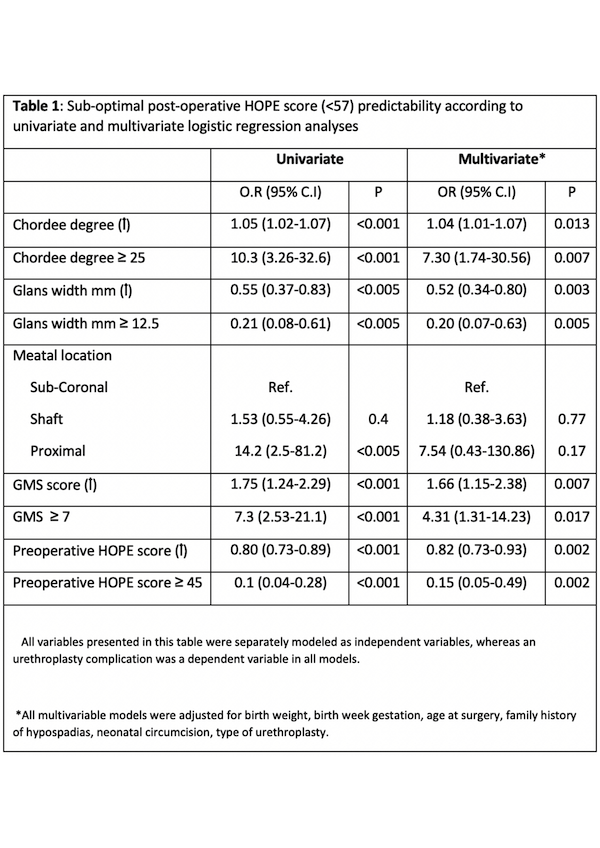Back
Poster, Podium & Video Sessions
Moderated Poster
MP08: Pediatric Urology: Penis & Scrotum
MP08-08: Predictors for Cosmetic Outcomes in Hypospadias Repair: Prospective Assessment Based on Validated Questionnaires
Friday, May 13, 2022
10:30 AM – 11:45 AM
Location: Room 225
Amos Neheman, Neena Carr*, Ilia Beberashvili, Amnon Zisman, Beer Yacov, Israel, Yuval Bar-Yosef, Tel Aviv, Israel, Kobi Stav, Beer Yacov, Israel
- NC
Poster Presenter(s)
Introduction: The importance of cosmetic considerations for hypospadias repair is well acknowledged. However, there is a paucity of literature examining preoperative determinants for cosmetic outcomes. Configuration of the glans, meatal appearance, penile skin properties and residual curvature define the cosmesis of the penis postoperatively. In this study, we aim to identify preoperative predictors of cosmetic outcomes.
Methods: This is a prospective cohort study of boys who underwent primary hypospadias repair between 2016 and 2020 (0064-17-ASF). Hypospadias-Objective-Penile-Evaluation (HOPE) scores, Glans-Urethral Meatus-Shaft (GMS) scores and physical examination parameters were obtained during preoperative assessment. The primary endpoint was a suboptimal ( <57) HOPE score assessed 6 months postoperatively. Univariate and multivariate logistic regression analyses were performed to determine the predictors of HOPE score.
Results: The group with optimal cosmetic results (HOPE = 57) consisted of 102 (81%) patients and the one with sub-optimal cosmetic outcome (HOPE < 57) included 24 (19%). Degree of curvature, glans width, GMS score and preoperative HOPE score were significant predictors of cosmetic outcomes by univariate logistic regression analysis. Of these, preoperative HOPE score was the strongest predictor: value =45 predicted 85% odds for optimal cosmetic outcomes. Although meatal location was as a predictor of sub-optimal cosmetic results in univariate analysis, it did not stand to multivariable adjustments. (Table 1)
Conclusions: In this cohort, 81% of boys undergoing hypospadias correction achieved optimal cosmetic outcomes. Preoperative HOPE score and GMS score are the best predictors for satisfactory cosmetic results after hypospadias surgery. These parameters should serve as a tool when consulting parents and patients regarding possible results of surgery.
Source of Funding: No funding was provided.

Methods: This is a prospective cohort study of boys who underwent primary hypospadias repair between 2016 and 2020 (0064-17-ASF). Hypospadias-Objective-Penile-Evaluation (HOPE) scores, Glans-Urethral Meatus-Shaft (GMS) scores and physical examination parameters were obtained during preoperative assessment. The primary endpoint was a suboptimal ( <57) HOPE score assessed 6 months postoperatively. Univariate and multivariate logistic regression analyses were performed to determine the predictors of HOPE score.
Results: The group with optimal cosmetic results (HOPE = 57) consisted of 102 (81%) patients and the one with sub-optimal cosmetic outcome (HOPE < 57) included 24 (19%). Degree of curvature, glans width, GMS score and preoperative HOPE score were significant predictors of cosmetic outcomes by univariate logistic regression analysis. Of these, preoperative HOPE score was the strongest predictor: value =45 predicted 85% odds for optimal cosmetic outcomes. Although meatal location was as a predictor of sub-optimal cosmetic results in univariate analysis, it did not stand to multivariable adjustments. (Table 1)
Conclusions: In this cohort, 81% of boys undergoing hypospadias correction achieved optimal cosmetic outcomes. Preoperative HOPE score and GMS score are the best predictors for satisfactory cosmetic results after hypospadias surgery. These parameters should serve as a tool when consulting parents and patients regarding possible results of surgery.
Source of Funding: No funding was provided.


.jpg)
.jpg)